
Next-Gen-Dialogue
AI powered dialogue visual designer for Unity
Stars: 89
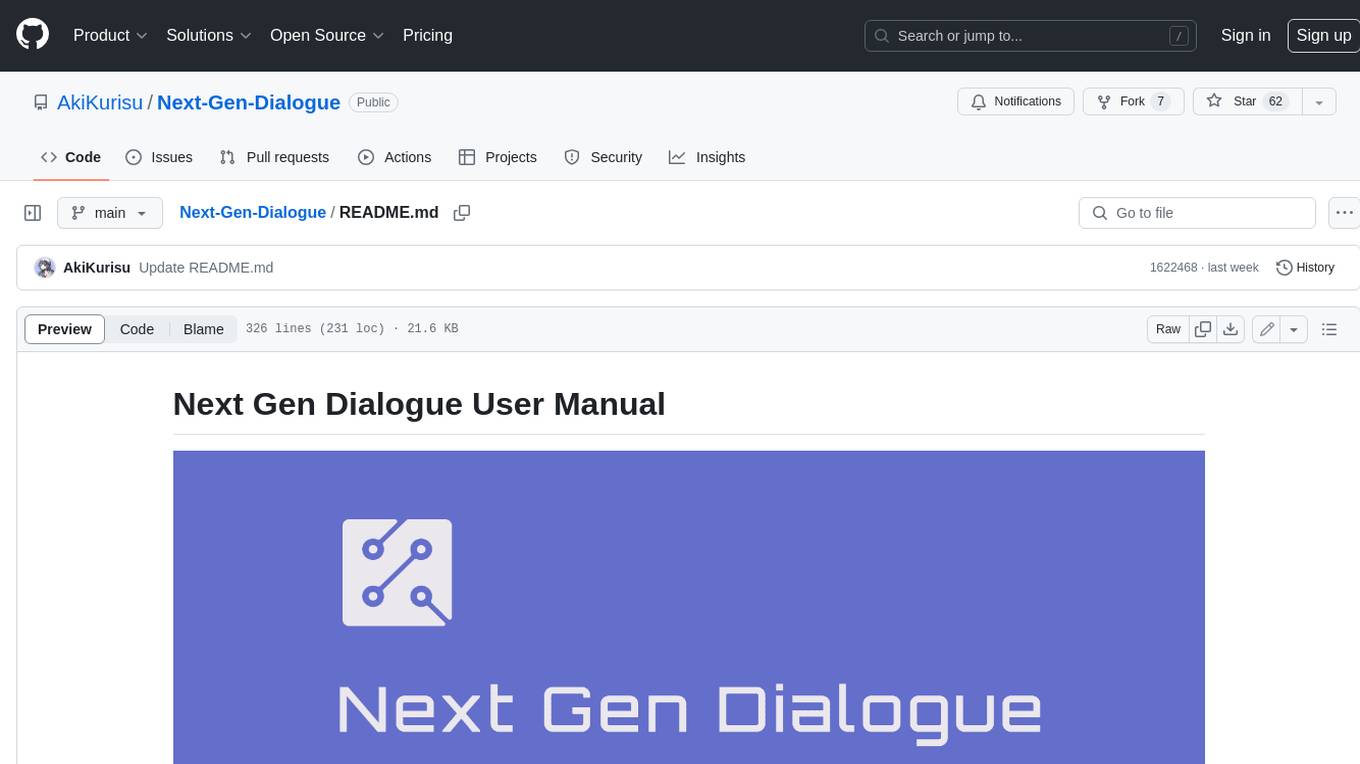
Next Gen Dialogue is a Unity dialogue plugin that combines traditional dialogue design with AI techniques. It features a visual dialogue editor, modular dialogue functions, AIGC support for generating dialogue at runtime, AIGC baking dialogue in Editor, and runtime debugging. The plugin aims to provide an experimental approach to dialogue design using large language models. Users can create dialogue trees, generate dialogue content using AI, and bake dialogue content in advance. The tool also supports localization, VITS speech synthesis, and one-click translation. Users can create dialogue by code using the DialogueSystem and DialogueTree components.
README:
Next Gen Dialogue is a Unity dialogue plugin combined with large language model design, won the 2023 Unity AI Plugin Excellence Award from Unity China.
It combines the traditional dialogue design pattern with AIGC to simlify your workflow. Hopes you enjoy it.

Demo video https://www.bilibili.com/video/BV1hg4y1U7FG
- Features
- Supported version
- Install
- Quick Start
- Nodes
- Modules
- Extensions
- Resolvers
- Create Dialogue in Script
- Visual dialogue editor
- Modular dialogue function
- AIGC dialogue
- Custom actions support
- Unity 2022.3 or Later
Using git URL to download package by Unity PackageManager https://github.com/AkiKurisu/Next-Gen-Dialogue.git
"dependencies": {
"com.kurisu.chris": "1.2.4",
"com.kurisu.chris-modules": "1.2.4",
"com.kurisu.ceres": "0.3.2",
"com.unity.nuget.newtonsoft-json": "3.2.1"
}The experimental features of Next Gen Dialogue are placed in the Modules folder and will not be enabled without installing the corresponding dependencies.
You can view the dependencies in the README.md document under its folder.
If you are using this plugin for the first time, it is recommended to play the following example scenes first:
1.Normal Usage.unity this scene contains the use of NextGenDialogueComponent and NextGenDialogueGraphAsset;
2.Editor Bake Dialogue.unitythis scene contains the sample of baking conversation conversation in the use of AI dialogue Baker in Editor;
3.Build Dialogue by Code.unity this scene contains the use of Code to generate dialogue.
4.Bake Novel.unity An example of using ChatGPT to infinitely generate dialogue trees.
NextGenDialogueComponent and NextGenDialogueGraphAsset are used to store dialogue data. In order to facilitate understanding, it is collectively referred to as dialogue tree.
The following process is to create a dialogue tree that contains only a single dialogue and a single option:
-
Mount
NextGenDialogueComponenton any gameObject -
Click
Open Dialogue Graphto enter the editor -
Create the Container/dialogue node, the node is the dialogue container used in the game
-
Connect the Parent port of the dialogue Node to the root node. You can have multiple dialogue in one dialogueTree, but only those connected to the root node will be used.
-
Create the Container/Piece node and create our first dialogue fragment
-
Right -click Piece node
Add ModuleaddContent Module, you can fill in the contents of the conversation inContent -
Create a Container/Option node and create a dialogue option corresponding to the PIECE node
-
Right-click Piece node
Add Option, connect Piece with Option -
Very important: At least one Piece node needs to be added to the Dialogue as the first piece of the dialogue. You can click
Collect All Piecesin context menu to collect all pieces in the Graph to the dialogue and adjust priority of them.- For priority, please refer to General Module-Condition Module

-
Click on the upper left of the editor's
Saveto save dialogue -
Click Play to enter PlayMode
-
Click on NextGenDialogueComponent
Play dialogueto play conversation -
Click
Open Dialogue Graphto enter the debug mode
The playing dialogue piece will be displayed in green
From V2, Next Gen Dialogue now use Ceres.Flow to implement custom action feature.
You can now add ExecuteFlowModule to fire a flow execution event at runtime.
For more details about Ceres.Flow, please refer to AkiKurisu/Ceres.
You can use AI dialogue Baker to bake the dialogue content generated by AI in advance when designing the dialogue tree, so as to improve the workflow efficiency without affecting your design framework.
- The basic dialogue graph design is consistent with the process of Create a Dialogue Graph
- Add
AI Bake Modulefor the fragments or options that need to be baked, and remove the module for nodes that do not need to be baked - Select the type of LLM you are baking with
- Select in turn the nodes that AI dialogue Baker needs to recognize, the order of recognition is based on the order selected by the mouse, and finally select the nodes that need to be baked
- If the selection is successful, you can see the preview input content at the bottom of the editor
- Click the
Bake Dialoguebutton on theAI Bake Moduleand wait for the AI response - After the language model responds, a
Content Modulewill be automatically added to the node to store the baked dialogue content - You can continuously generate conversations based on your needs
Different from talking directly to AI in baking dialogue, novel mode allows AI to play the role of copywriter and planner to write dialogue, so it can control options and fragments more precisely. Please refer to the example: 4.Bake Novel.unity
NGD use node based visual editor framework, most of the features are presented through nodes. The construction dialogue are divided into the following parts in NGD:
| Name | Description |
|---|---|
| Dialogue | Used to define dialogues, such as the first piece of the dialogue and other attributes |
| Piece | dialogue piece, usually store the core dialogue content |
| Option | dialogue options, usually used for interaction and bridging dialogues |
In addition to the above nodes, a more flexible concept is used in NGD, that is, Module. You can use Module to change the output form of the dialogue, such as Google translation, localization, add callbacks, or be executed as a markup.
The following are built-in general modules:
| Name | Description |
|---|---|
| Content | Provide text content for Option or Piece |
| TargetID | Add jumping target dialogue fragments for Option |
| PreUpdate | Add pre-update behavior for Container, it will update when jumping to the Container |
| Callback | Add callback behavior for Option, they will be updated after selection |
| Condition | Add judgment behavior for Option or Piece, it will be updated when jumping to the Container, if the return value is Status.Failure, the Container will be discarded. If it is the first Piece of the dialogue, the system will try to jump to the next Piece according to the order in which the Pieces are placed in the dialogue |
| Next Piece | Add the next dialogue segment after the end of the Piece. If there is no option, it will jump to the specified dialogue segment after playing the content of the Piece |
| Google Translate | Use Google Translate to translate the content of current Option or Piece |
The following are the built-in AIGC modules:
| Name | Description |
|---|---|
| Prompt | Prompt words that provide the basis for subsequent dialogue generation |
Editor modules are used to provide some useful tools for the editor, such as translation.
Add Editor/EditorTranslateModule in the Dialogue node, set the source language (sourceLanguageCode) and target language (targetLanguageCode) of the translation, right-click and select Translate All Contents to perform all Piece and Option with ContentModule translate.
For nodes other than ContentModule, if the TranslateEntryAttribute is added to the field, you can right-click a single node to translate it.
public class ExampleAction : Action
{
//Notify field can be translated
//* Only work for SharedString and string
[SerializeField, Multiline, TranslateEntry]
private SharedString value;
}The following are extensions, you need to install the corresponding Package or configure the corresponding environment before use:
Based on the UnityEngine.Localization plugin to support the localization of dialogue
| Name | Description |
|---|---|
| Localized Content | Provide content for Option or Piece after getting text from localization |
For VITS local deployment, please refer to this repository: VITS Simple API
If you want to use the VITS module, please use it with VITSAIReResolver. For the use of the Resolver, please refer to the following Resolver
| Name | Description |
|---|---|
| VITS Voice | Use VITS speech synthesis model to generate language for Piece or Option in real time |
Before use, you need to install the corresponding dependencies of Modules/VITS and open the local VITS server (refer to Modules/VITS/README.md). Add AIGC/VITSModule to the node where speech needs to be generated, right-click and select Bake Audio
If you are satisfied with the generated audio, click Download to save it locally to complete the baking, otherwise the audio file will not be retained after exiting the editor.
It is no longer necessary to start the VITS server at runtime after baking is complete.
- If the AudioClip field is empty, the run generation mode is enabled by default. If there is no connection, the conversation may not proceed. If you only need to use the baking function, please keep the AudioClip field not empty at all times.
Resolver is used to detect the Module in the Container at runtime and execute a series of preset logic such as injecting dependencies and executing behaviors, the difference between NGD's built-in Resolver is as follows:
| Name | Description |
|---|---|
| Default Resolver | The most basic resolver, supporting all built-in common modules |
| VITS Resolver | Additionally detect VITS modules to generate voice in real time |
-
In-scene Global Resolver You can mount the
VITSSetupscript on any GameObject to enable AIResolver in the scene -
Dialogue specified Resolver
You can add
VITSResolverModuleto the dialogue node to specify the resolver used by the dialogue, and you can also click the Setting button in the upper right corner of the module and select which Resolvers to be replaced inAdvanced Settings
NGD is divided into two parts, DialogueSystem and DialogueGraph. The former defines the data structure of the dialogue, which is interpreted by resolver after receiving the data. The latter provides a visual scripting solution and inherits the interface from the former. So you can also use scripts to write dialogues, examples are as follows:
using UnityEngine;
public class CodeDialogueBuilder : MonoBehaviour
{
private RuntimeDialogueBuilder _builder;
private void Start()
{
PlayDialogue();
}
private void PlayDialogue()
{
var dialogueSystem = DialogueSystem.Get();
_builder = new RuntimeDialogueBuilder();
// First Piece
_builder.AddPiece(GetFirstPiece());
// Second Piece
_builder.AddPiece(GetSecondPiece());
dialogueSystem.StartDialogue(_builder);
}
private static Piece GetFirstPiece()
{
var piece = Piece.GetPooled();
piece.AddContent("This is the first dialogue piece");
piece.ID = "01";
piece.AddOption(new Option
{
Content = "Jump to Next",
TargetID = "02"
});
return piece;
}
private static Piece GetSecondPiece()
{
var piece = Piece.GetPooled();
piece.AddContent("This is the second dialogue piece");
piece.ID = "02";
piece.AddOption(GetFirstOption());
piece.AddOption(GetSecondOption());
return piece;
}
private static Option GetFirstOption()
{
var callBackOption = Option.GetPooled();
// Add CallBack Module
callBackOption.AddModule(new CallBackModule(() => Debug.Log("Hello World!")));
callBackOption.Content = "Log";
return callBackOption;
}
private static Option GetSecondOption()
{
var option = Option.GetPooled();
option.Content = "Back To First";
option.TargetID = "01";
return option;
}
}For Tasks:
Click tags to check more tools for each tasksFor Jobs:
Alternative AI tools for Next-Gen-Dialogue
Similar Open Source Tools

Next-Gen-Dialogue
Next Gen Dialogue is a Unity dialogue plugin that combines traditional dialogue design with AI techniques. It features a visual dialogue editor, modular dialogue functions, AIGC support for generating dialogue at runtime, AIGC baking dialogue in Editor, and runtime debugging. The plugin aims to provide an experimental approach to dialogue design using large language models. Users can create dialogue trees, generate dialogue content using AI, and bake dialogue content in advance. The tool also supports localization, VITS speech synthesis, and one-click translation. Users can create dialogue by code using the DialogueSystem and DialogueTree components.
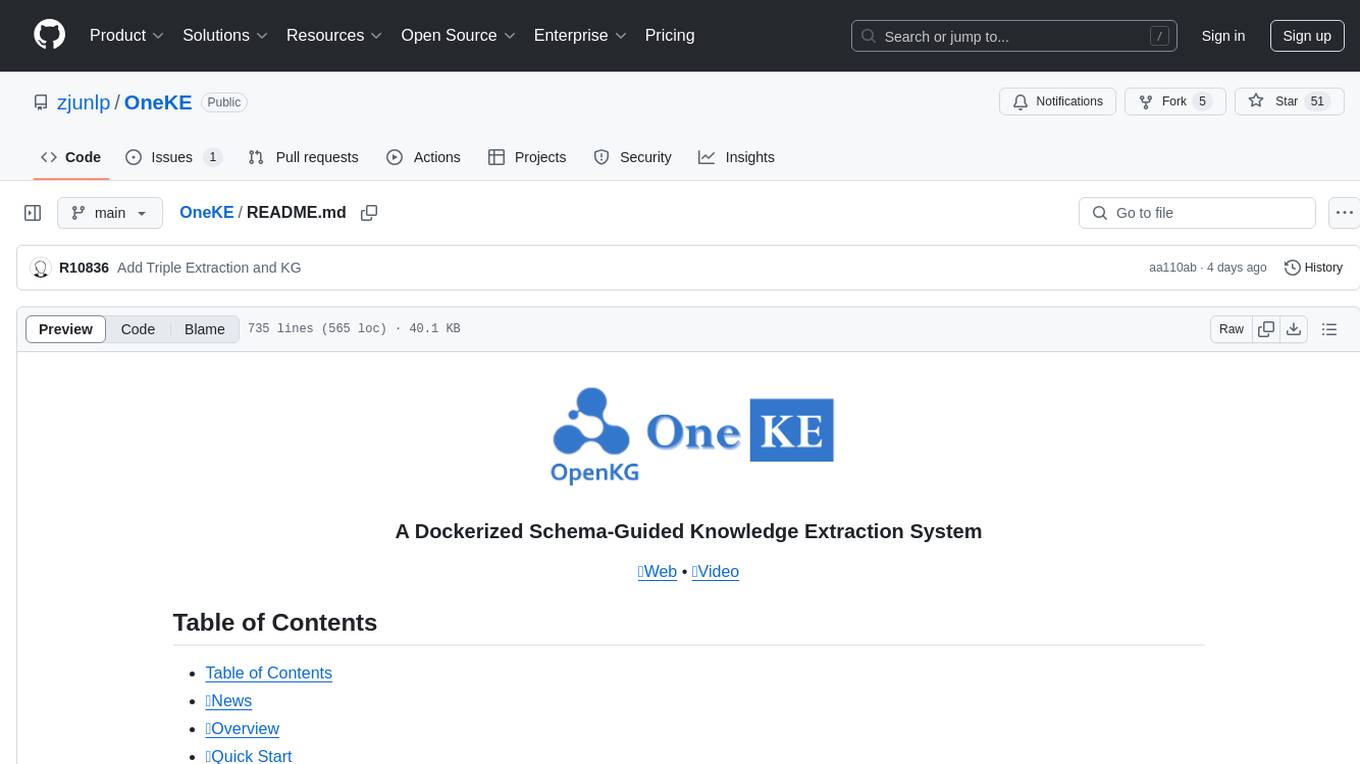
OneKE
OneKE is a flexible dockerized system for schema-guided knowledge extraction, capable of extracting information from the web and raw PDF books across multiple domains like science and news. It employs a collaborative multi-agent approach and includes a user-customizable knowledge base to enable tailored extraction. OneKE offers various IE tasks support, data sources support, LLMs support, extraction method support, and knowledge base configuration. Users can start with examples using YAML, Python, or Web UI, and perform tasks like Named Entity Recognition, Relation Extraction, Event Extraction, Triple Extraction, and Open Domain IE. The tool supports different source formats like Plain Text, HTML, PDF, Word, TXT, and JSON files. Users can choose from various extraction models like OpenAI, DeepSeek, LLaMA, Qwen, ChatGLM, MiniCPM, and OneKE for information extraction tasks. Extraction methods include Schema Agent, Extraction Agent, and Reflection Agent. The tool also provides support for schema repository and case repository management, along with solutions for network issues. Contributors to the project include Ningyu Zhang, Haofen Wang, Yujie Luo, Xiangyuan Ru, Kangwei Liu, Lin Yuan, Mengshu Sun, Lei Liang, Zhiqiang Zhang, Jun Zhou, Lanning Wei, Da Zheng, and Huajun Chen.
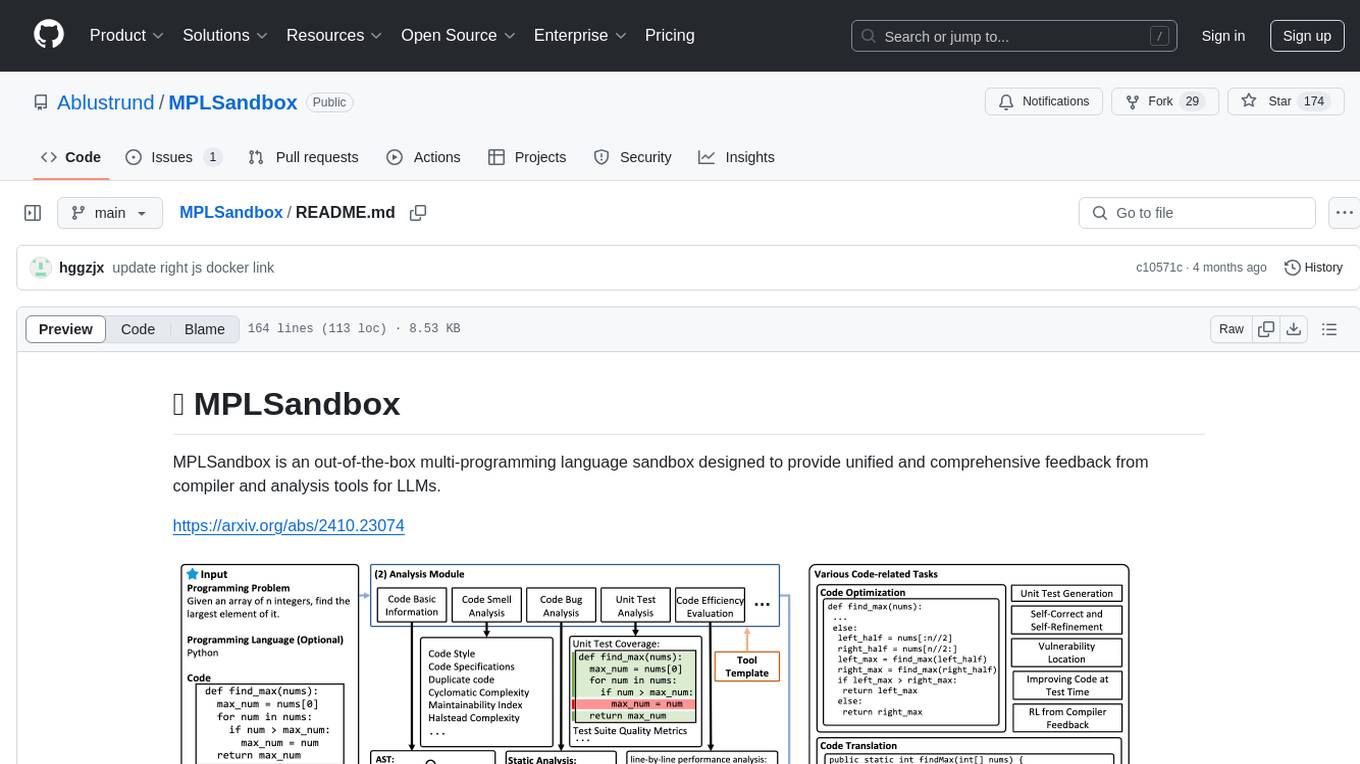
MPLSandbox
MPLSandbox is an out-of-the-box multi-programming language sandbox designed to provide unified and comprehensive feedback from compiler and analysis tools for LLMs. It simplifies code analysis for researchers and can be seamlessly integrated into LLM training and application processes to enhance performance in a range of code-related tasks. The sandbox environment ensures safe code execution, the code analysis module offers comprehensive analysis reports, and the information integration module combines compilation feedback and analysis results for complex code-related tasks.
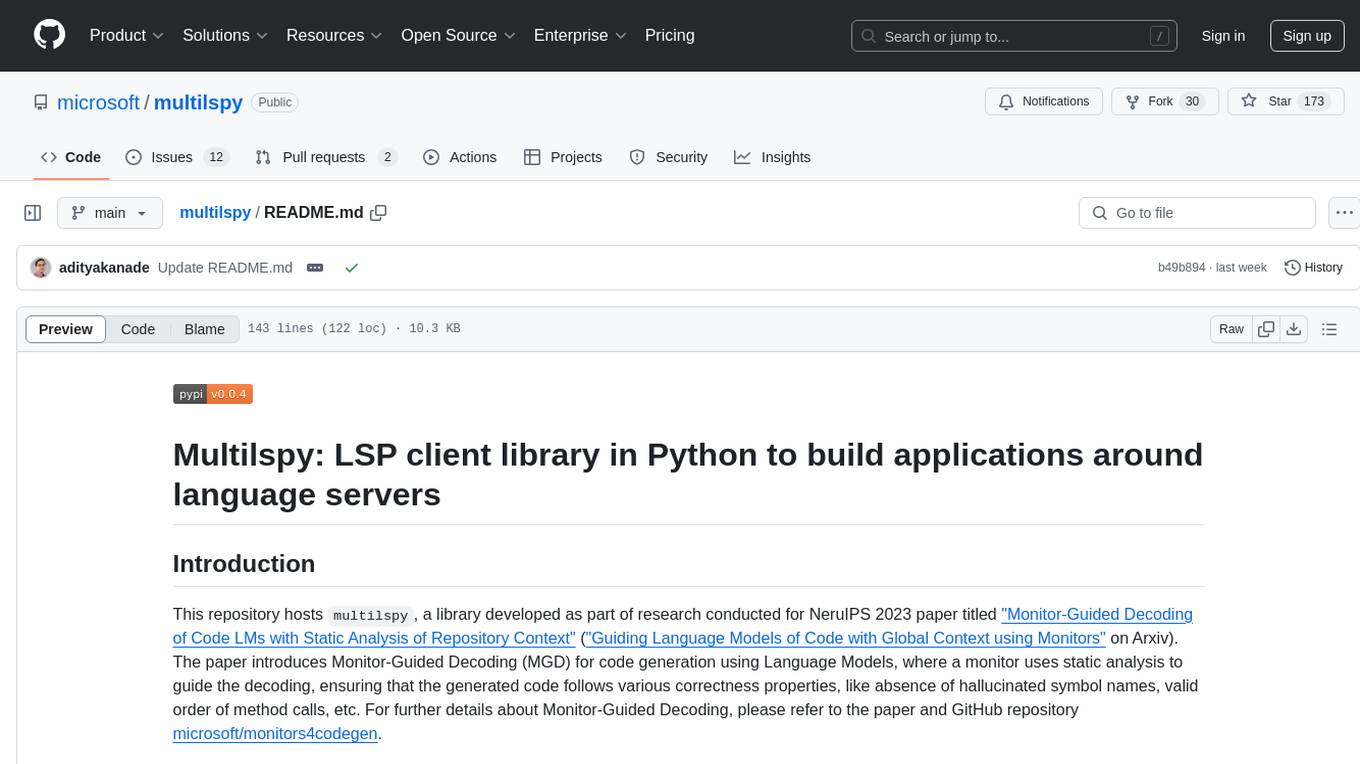
multilspy
Multilspy is a Python library developed for research purposes to facilitate the creation of language server clients for querying and obtaining results of static analyses from various language servers. It simplifies the process by handling server setup, communication, and configuration parameters, providing a common interface for different languages. The library supports features like finding function/class definitions, callers, completions, hover information, and document symbols. It is designed to work with AI systems like Large Language Models (LLMs) for tasks such as Monitor-Guided Decoding to ensure code generation correctness and boost compilability.
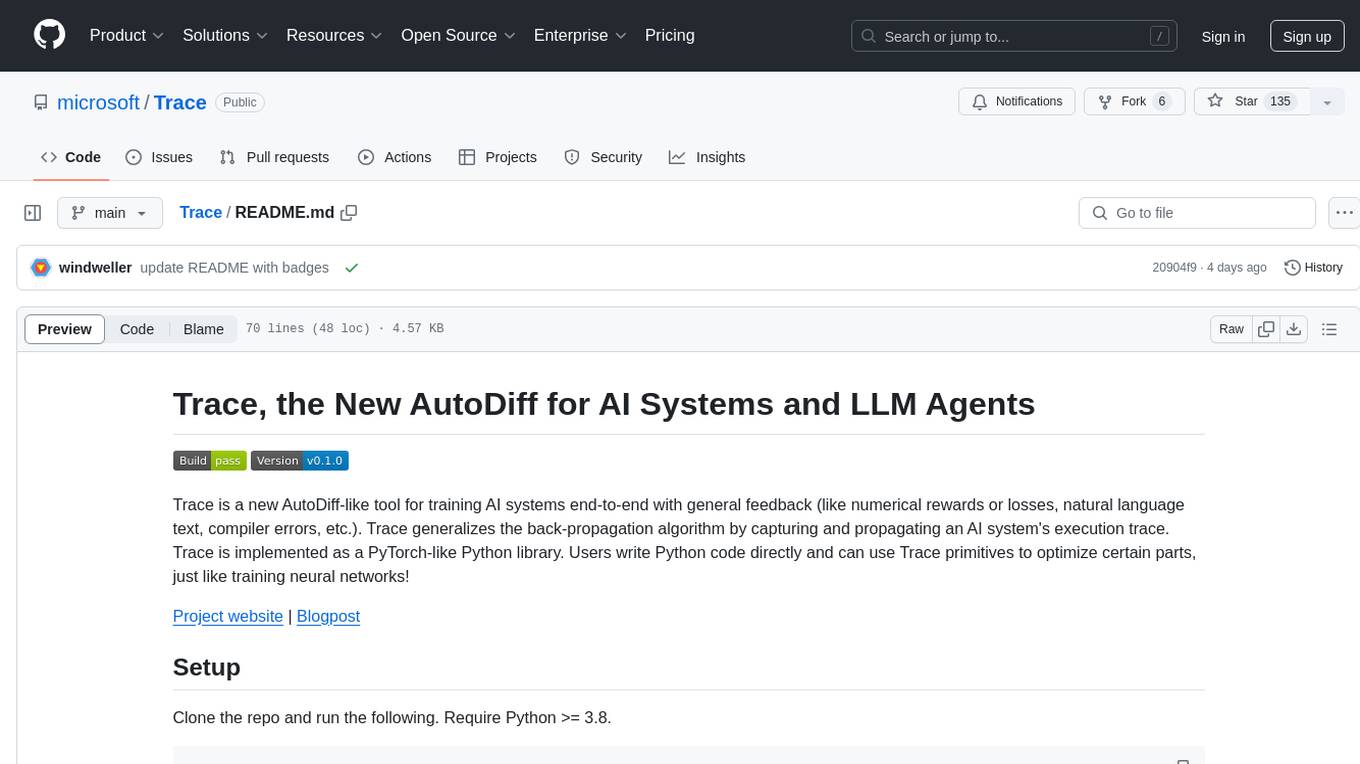
Trace
Trace is a new AutoDiff-like tool for training AI systems end-to-end with general feedback. It generalizes the back-propagation algorithm by capturing and propagating an AI system's execution trace. Implemented as a PyTorch-like Python library, users can write Python code directly and use Trace primitives to optimize certain parts, similar to training neural networks.
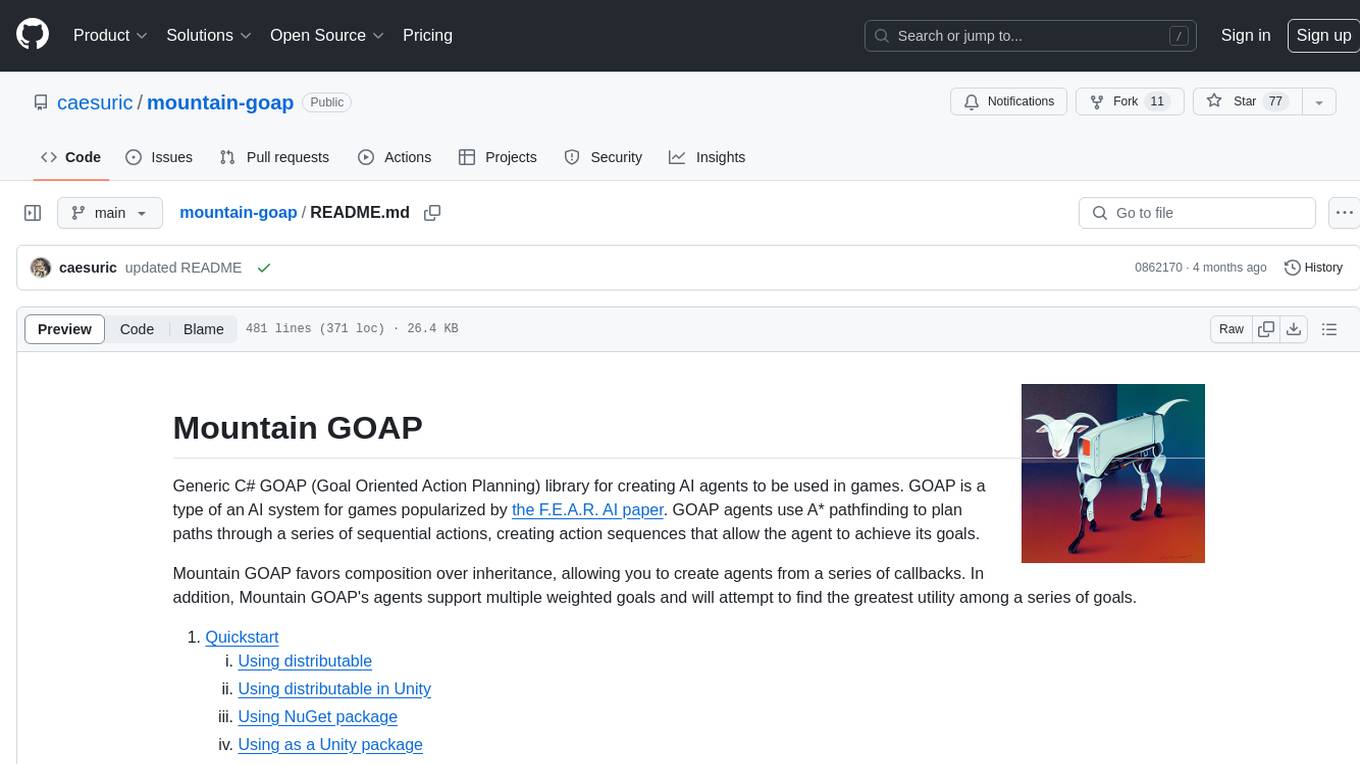
mountain-goap
Mountain GOAP is a generic C# GOAP (Goal Oriented Action Planning) library for creating AI agents in games. It favors composition over inheritance, supports multiple weighted goals, and uses A* pathfinding to plan paths through sequential actions. The library includes concepts like agents, goals, actions, sensors, permutation selectors, cost callbacks, state mutators, state checkers, and a logger. It also features event handling for agent planning and execution. The project structure includes examples, API documentation, and internal classes for planning and execution.
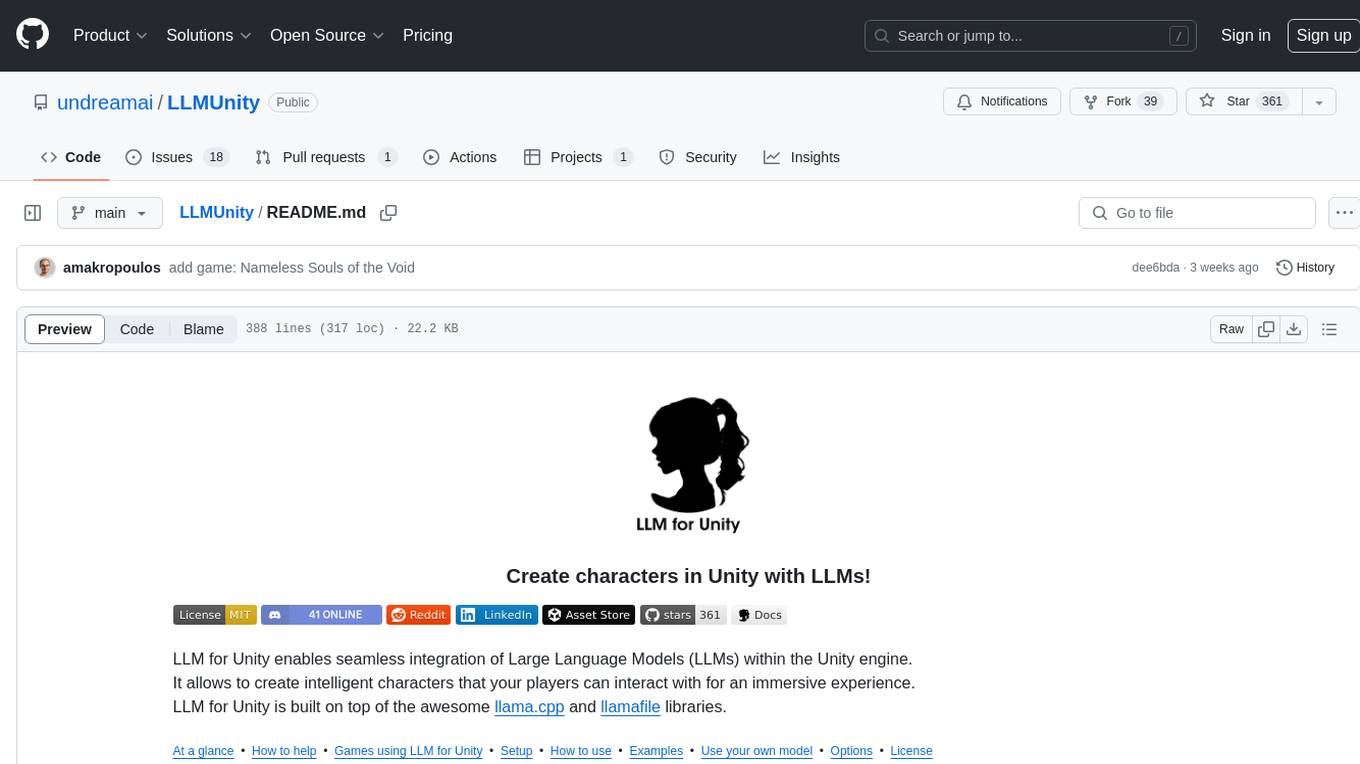
LLMUnity
LLM for Unity enables seamless integration of Large Language Models (LLMs) within the Unity engine, allowing users to create intelligent characters for immersive player interactions. The tool supports major LLM models, runs locally without internet access, offers fast inference on CPU and GPU, and is easy to set up with a single line of code. It is free for both personal and commercial use, tested on Unity 2021 LTS, 2022 LTS, and 2023. Users can build multiple AI characters efficiently, use remote servers for processing, and customize model settings for text generation.

onnxruntime-genai
ONNX Runtime Generative AI is a library that provides the generative AI loop for ONNX models, including inference with ONNX Runtime, logits processing, search and sampling, and KV cache management. Users can call a high level `generate()` method, or run each iteration of the model in a loop. It supports greedy/beam search and TopP, TopK sampling to generate token sequences, has built in logits processing like repetition penalties, and allows for easy custom scoring.
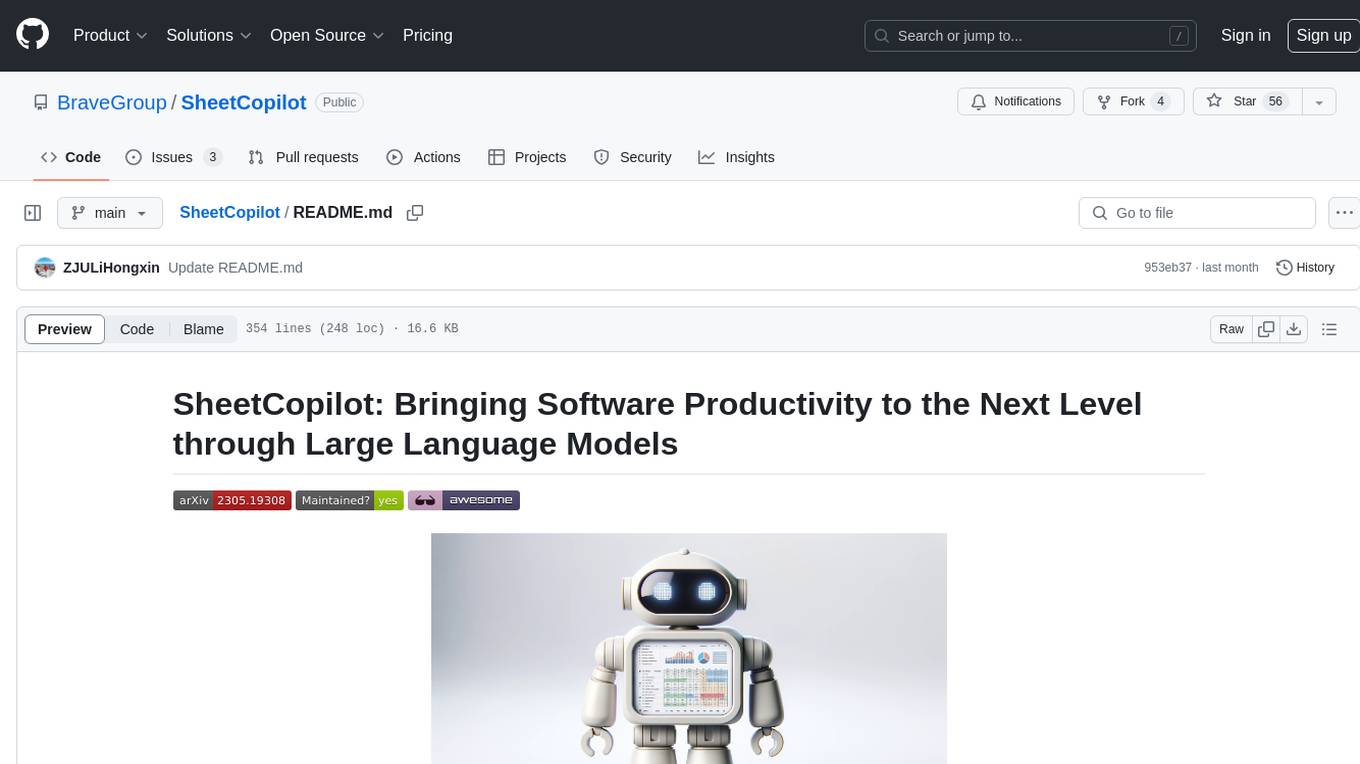
SheetCopilot
SheetCopilot is an assistant agent that manipulates spreadsheets by following user commands. It leverages Large Language Models (LLMs) to interact with spreadsheets like a human expert, enabling non-expert users to complete tasks on complex software such as Google Sheets and Excel via a language interface. The tool observes spreadsheet states, polishes generated solutions based on external action documents and error feedback, and aims to improve success rate and efficiency. SheetCopilot offers a dataset with diverse task categories and operations, supporting operations like entry & manipulation, management, formatting, charts, and pivot tables. Users can interact with SheetCopilot in Excel or Google Sheets, executing tasks like calculating revenue, creating pivot tables, and plotting charts. The tool's evaluation includes performance comparisons with leading LLMs and VBA-based methods on specific datasets, showcasing its capabilities in controlling various aspects of a spreadsheet.
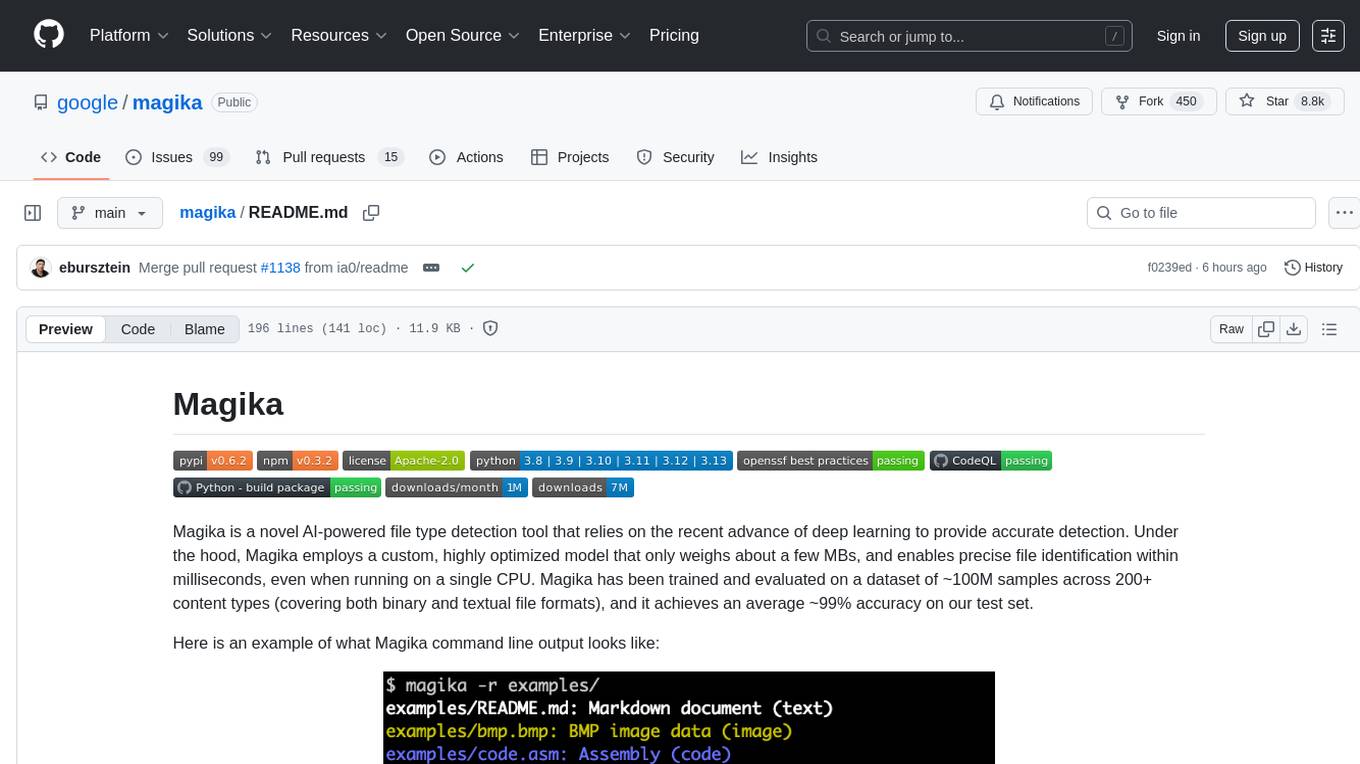
magika
Magika is a novel AI-powered file type detection tool that relies on deep learning to provide accurate detection. It employs a custom, highly optimized model to enable precise file identification within milliseconds. Trained on a dataset of ~100M samples across 200+ content types, achieving an average ~99% accuracy. Used at scale by Google to improve user safety by routing files to security scanners. Available as a command line tool in Rust, Python API, and bindings for Rust, JavaScript/TypeScript, and GoLang.
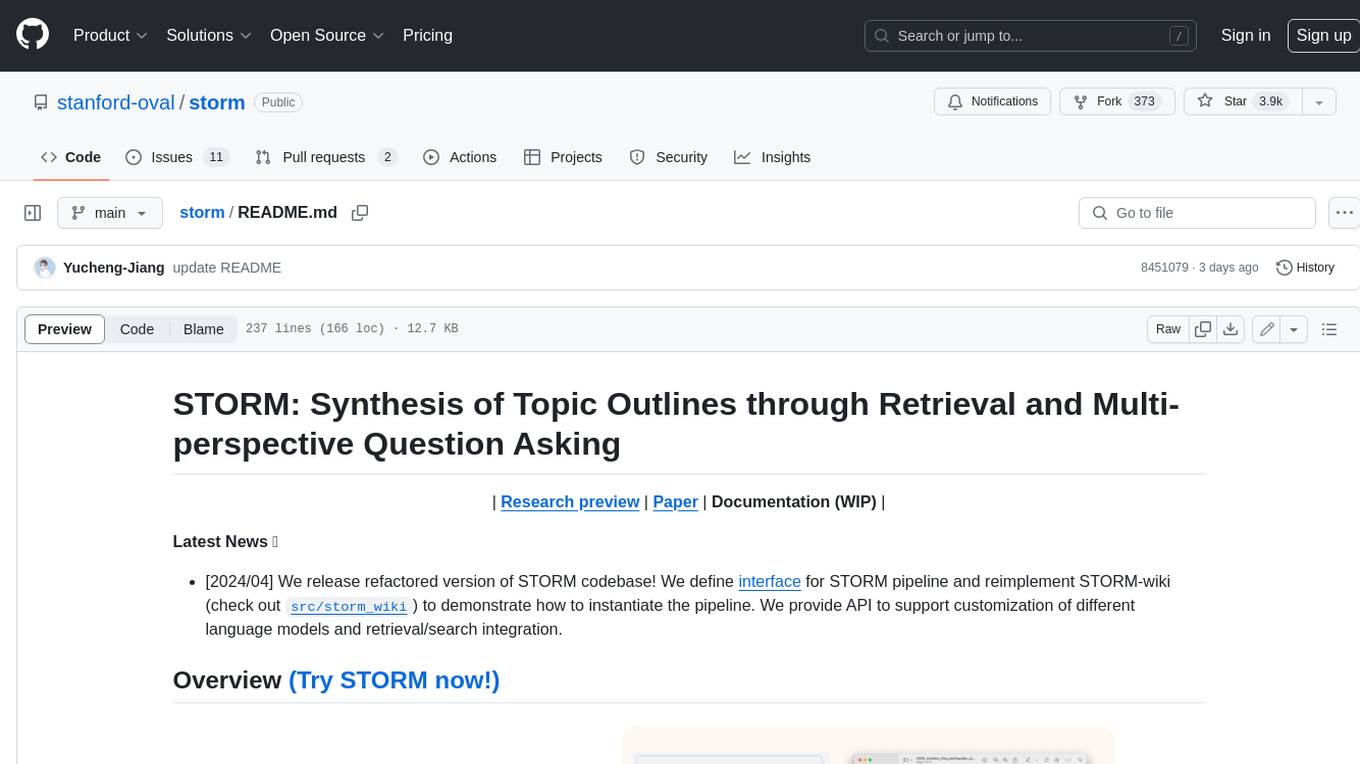
storm
STORM is a LLM system that writes Wikipedia-like articles from scratch based on Internet search. While the system cannot produce publication-ready articles that often require a significant number of edits, experienced Wikipedia editors have found it helpful in their pre-writing stage. **Try out our [live research preview](https://storm.genie.stanford.edu/) to see how STORM can help your knowledge exploration journey and please provide feedback to help us improve the system 🙏!**
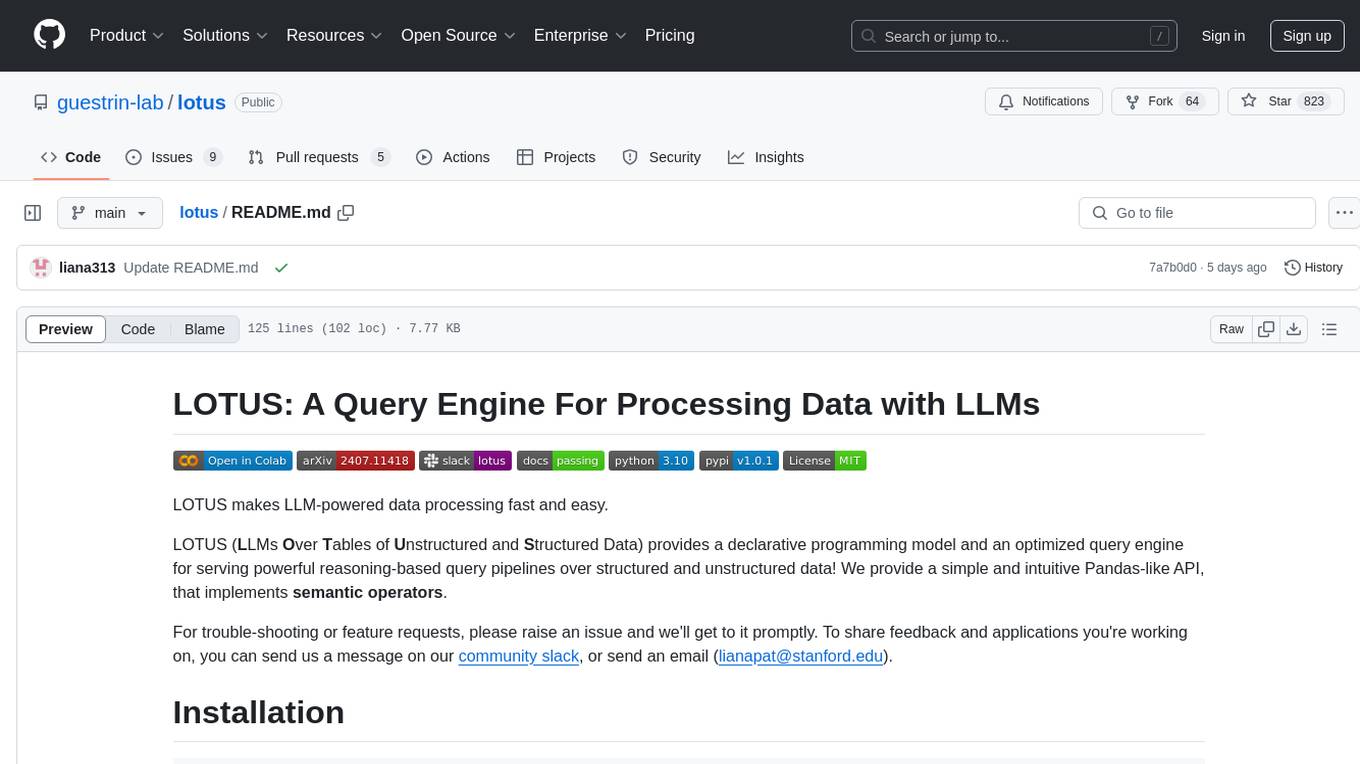
lotus
LOTUS (LLMs Over Tables of Unstructured and Structured Data) is a query engine that provides a declarative programming model and an optimized query engine for reasoning-based query pipelines over structured and unstructured data. It offers a simple and intuitive Pandas-like API with semantic operators for fast and easy LLM-powered data processing. The tool implements a semantic operator programming model, allowing users to write AI-based pipelines with high-level logic and leaving the rest of the work to the query engine. LOTUS supports various semantic operators like sem_map, sem_filter, sem_extract, sem_agg, sem_topk, sem_join, sem_sim_join, and sem_search, enabling users to perform tasks like mapping records, filtering data, aggregating records, and more. The tool also supports different model classes such as LM, RM, and Reranker for language modeling, retrieval, and reranking tasks respectively.
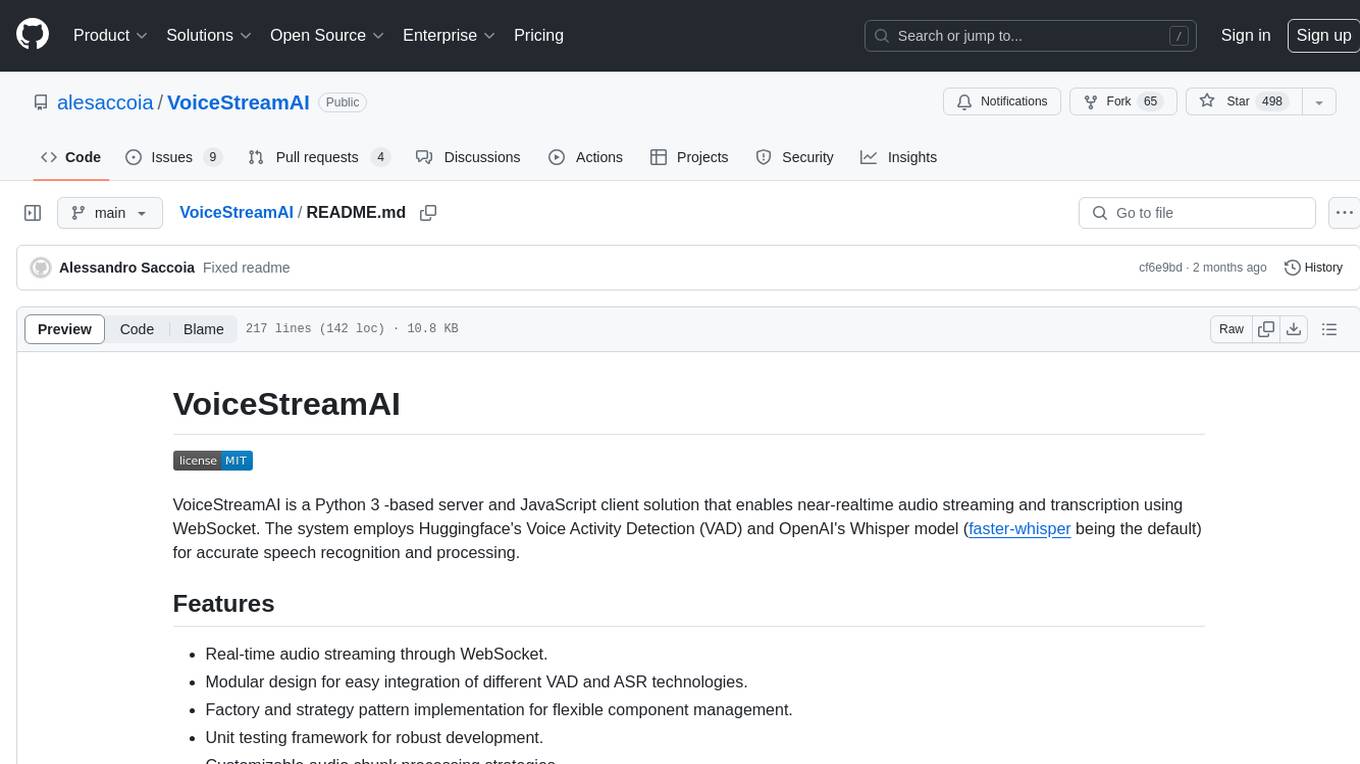
VoiceStreamAI
VoiceStreamAI is a Python 3-based server and JavaScript client solution for near-realtime audio streaming and transcription using WebSocket. It employs Huggingface's Voice Activity Detection (VAD) and OpenAI's Whisper model for accurate speech recognition. The system features real-time audio streaming, modular design for easy integration of VAD and ASR technologies, customizable audio chunk processing strategies, support for multilingual transcription, and secure sockets support. It uses a factory and strategy pattern implementation for flexible component management and provides a unit testing framework for robust development.
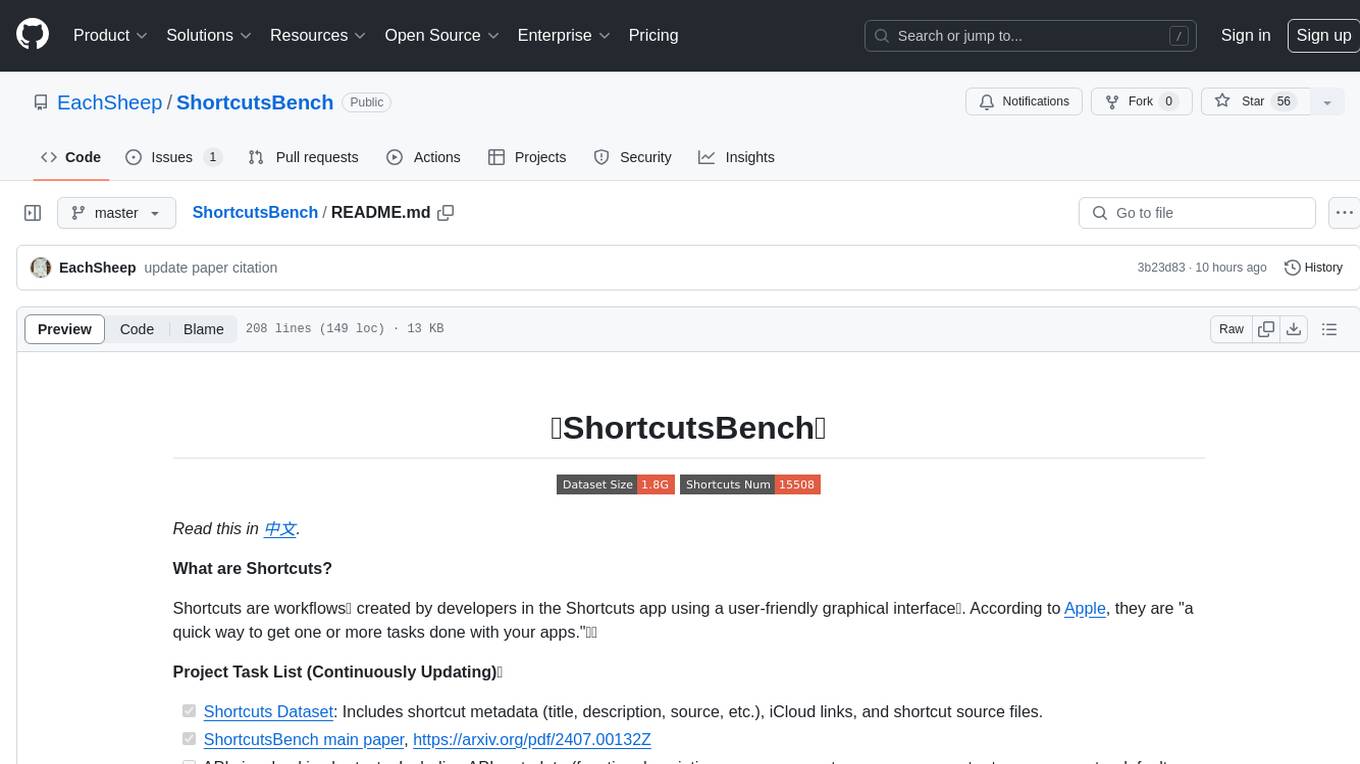
ShortcutsBench
ShortcutsBench is a project focused on collecting and analyzing workflows created in the Shortcuts app, providing a dataset of shortcut metadata, source files, and API information. It aims to study the integration of large language models with Apple devices, particularly focusing on the role of shortcuts in enhancing user experience. The project offers insights for Shortcuts users, enthusiasts, and researchers to explore, customize workflows, and study automated workflows, low-code programming, and API-based agents.
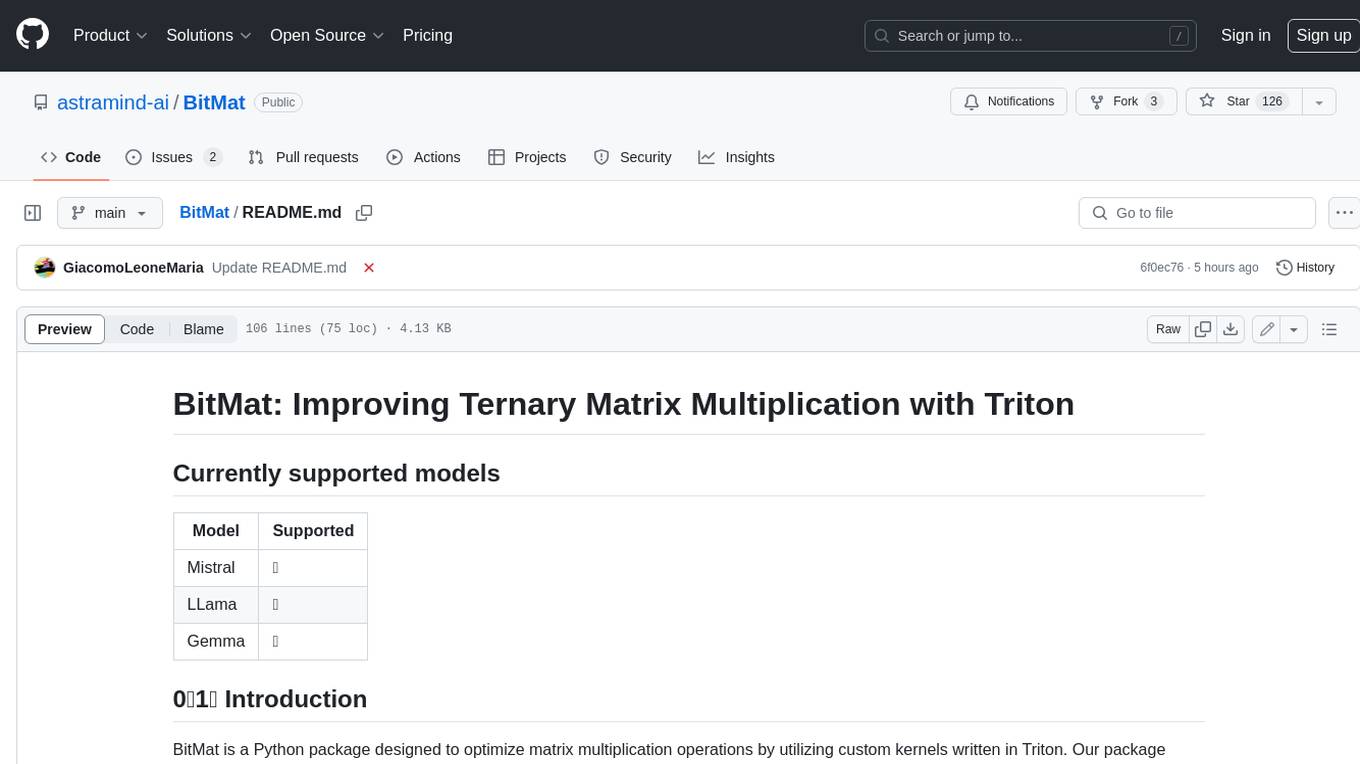
BitMat
BitMat is a Python package designed to optimize matrix multiplication operations by utilizing custom kernels written in Triton. It leverages the principles outlined in the "1bit-LLM Era" paper, specifically utilizing packed int8 data to enhance computational efficiency and performance in deep learning and numerical computing tasks.
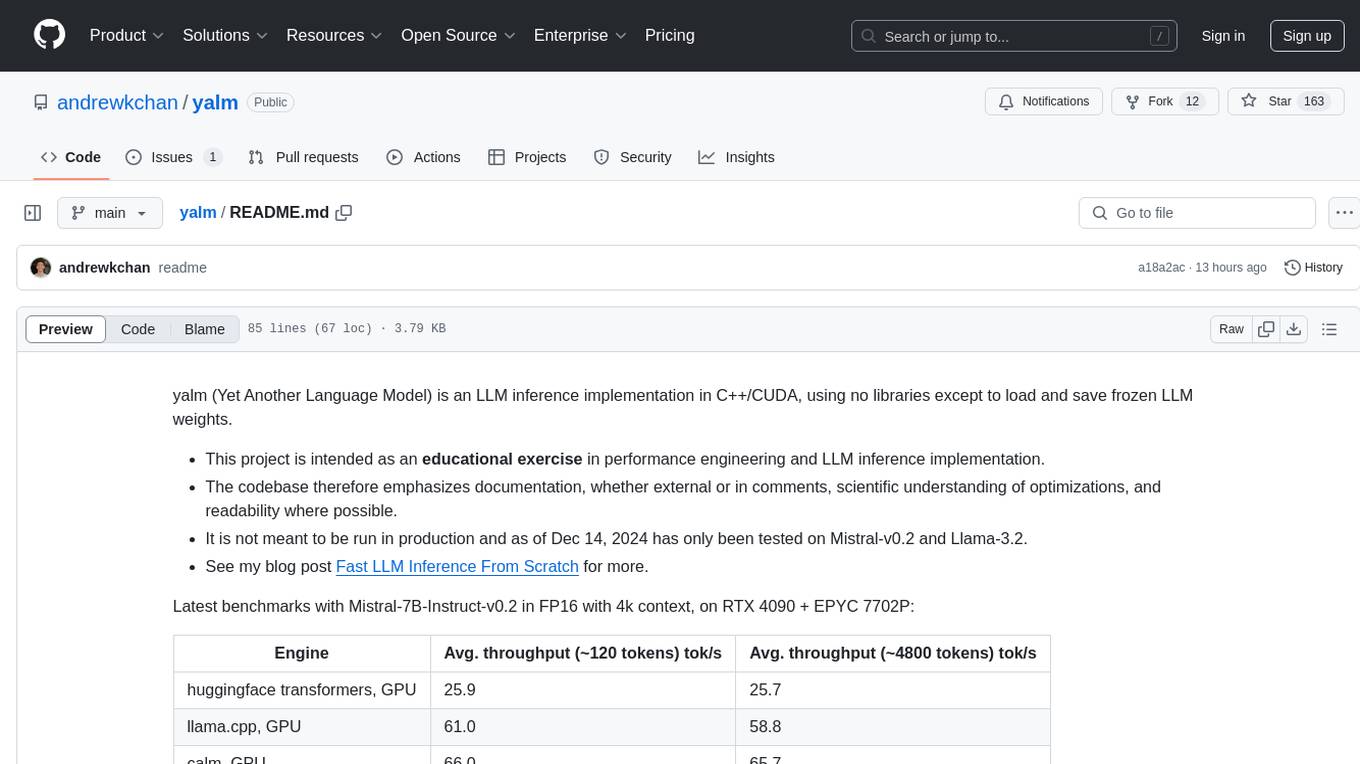
yalm
Yalm (Yet Another Language Model) is an LLM inference implementation in C++/CUDA, emphasizing performance engineering, documentation, scientific optimizations, and readability. It is not for production use and has been tested on Mistral-v0.2 and Llama-3.2. Requires C++20-compatible compiler, CUDA toolkit, and LLM safetensor weights in huggingface format converted to .yalm file.
For similar tasks

Next-Gen-Dialogue
Next Gen Dialogue is a Unity dialogue plugin that combines traditional dialogue design with AI techniques. It features a visual dialogue editor, modular dialogue functions, AIGC support for generating dialogue at runtime, AIGC baking dialogue in Editor, and runtime debugging. The plugin aims to provide an experimental approach to dialogue design using large language models. Users can create dialogue trees, generate dialogue content using AI, and bake dialogue content in advance. The tool also supports localization, VITS speech synthesis, and one-click translation. Users can create dialogue by code using the DialogueSystem and DialogueTree components.
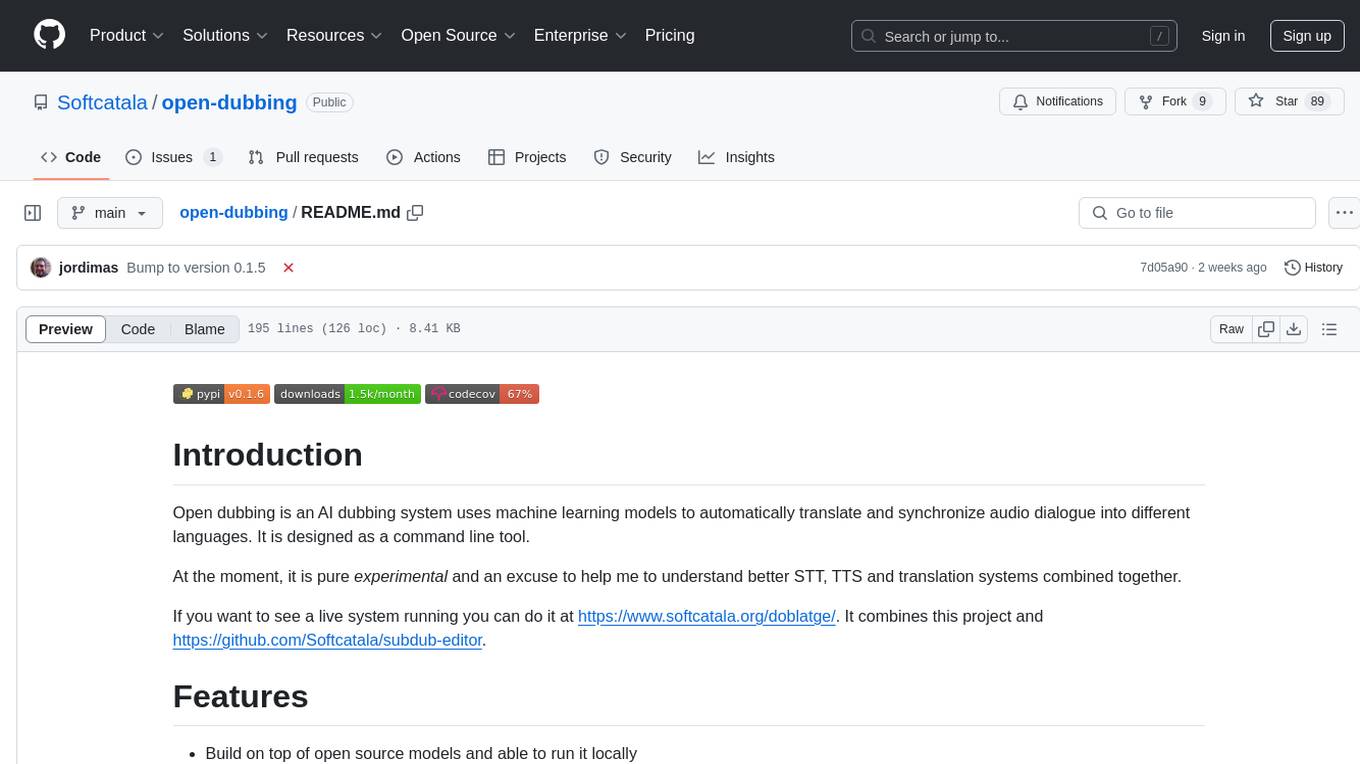
open-dubbing
Open dubbing is an AI dubbing system that uses machine learning models to automatically translate and synchronize audio dialogue into different languages. It is designed as a command line tool. The project is experimental and aims to explore speech-to-text, text-to-speech, and translation systems combined. It supports multiple text-to-speech engines, translation engines, and gender voice detection. The tool can automatically dub videos, detect source language, and is built on open-source models. The roadmap includes better voice control, optimization for long videos, and support for multiple video input formats. Users can post-edit dubbed files by manually adjusting text, voice, and timings. Supported languages vary based on the combination of systems used.
For similar jobs

promptflow
**Prompt flow** is a suite of development tools designed to streamline the end-to-end development cycle of LLM-based AI applications, from ideation, prototyping, testing, evaluation to production deployment and monitoring. It makes prompt engineering much easier and enables you to build LLM apps with production quality.

deepeval
DeepEval is a simple-to-use, open-source LLM evaluation framework specialized for unit testing LLM outputs. It incorporates various metrics such as G-Eval, hallucination, answer relevancy, RAGAS, etc., and runs locally on your machine for evaluation. It provides a wide range of ready-to-use evaluation metrics, allows for creating custom metrics, integrates with any CI/CD environment, and enables benchmarking LLMs on popular benchmarks. DeepEval is designed for evaluating RAG and fine-tuning applications, helping users optimize hyperparameters, prevent prompt drifting, and transition from OpenAI to hosting their own Llama2 with confidence.
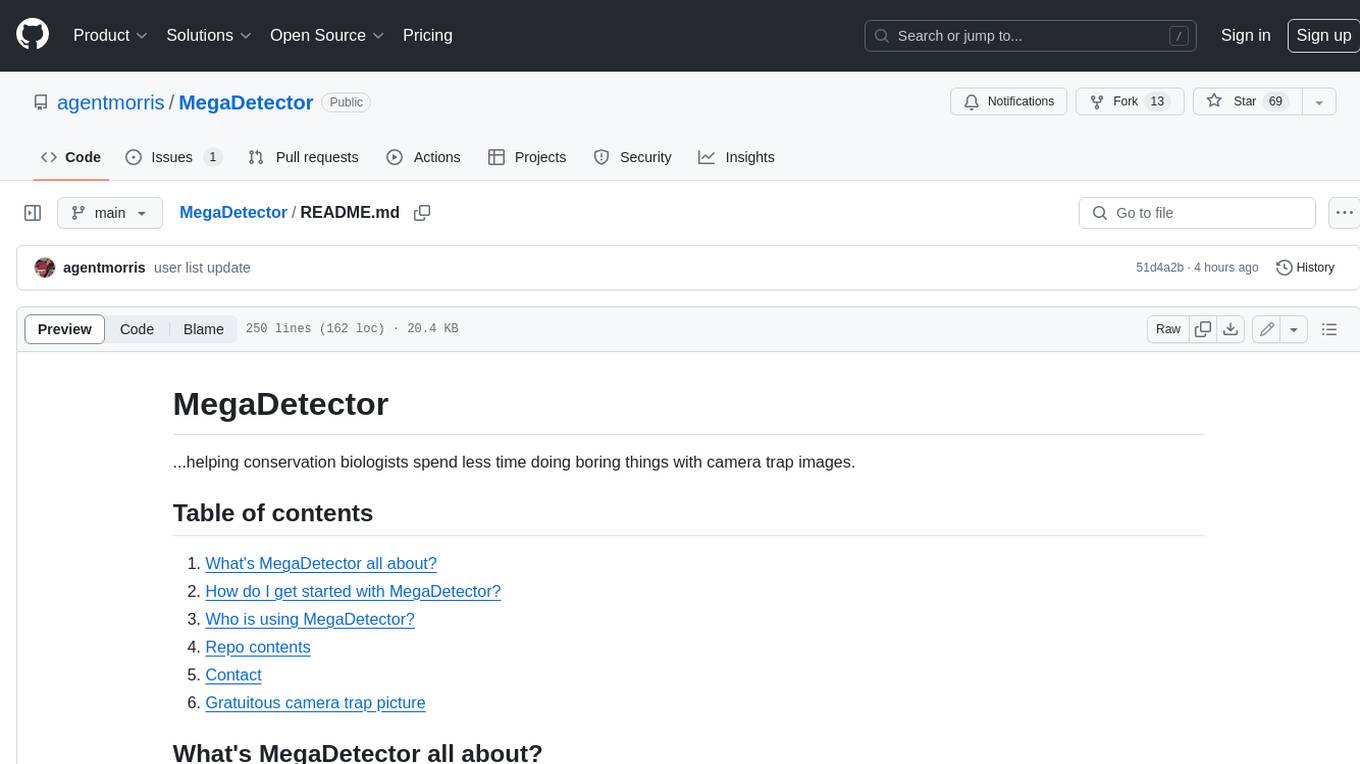
MegaDetector
MegaDetector is an AI model that identifies animals, people, and vehicles in camera trap images (which also makes it useful for eliminating blank images). This model is trained on several million images from a variety of ecosystems. MegaDetector is just one of many tools that aims to make conservation biologists more efficient with AI. If you want to learn about other ways to use AI to accelerate camera trap workflows, check out our of the field, affectionately titled "Everything I know about machine learning and camera traps".

leapfrogai
LeapfrogAI is a self-hosted AI platform designed to be deployed in air-gapped resource-constrained environments. It brings sophisticated AI solutions to these environments by hosting all the necessary components of an AI stack, including vector databases, model backends, API, and UI. LeapfrogAI's API closely matches that of OpenAI, allowing tools built for OpenAI/ChatGPT to function seamlessly with a LeapfrogAI backend. It provides several backends for various use cases, including llama-cpp-python, whisper, text-embeddings, and vllm. LeapfrogAI leverages Chainguard's apko to harden base python images, ensuring the latest supported Python versions are used by the other components of the stack. The LeapfrogAI SDK provides a standard set of protobuffs and python utilities for implementing backends and gRPC. LeapfrogAI offers UI options for common use-cases like chat, summarization, and transcription. It can be deployed and run locally via UDS and Kubernetes, built out using Zarf packages. LeapfrogAI is supported by a community of users and contributors, including Defense Unicorns, Beast Code, Chainguard, Exovera, Hypergiant, Pulze, SOSi, United States Navy, United States Air Force, and United States Space Force.

llava-docker
This Docker image for LLaVA (Large Language and Vision Assistant) provides a convenient way to run LLaVA locally or on RunPod. LLaVA is a powerful AI tool that combines natural language processing and computer vision capabilities. With this Docker image, you can easily access LLaVA's functionalities for various tasks, including image captioning, visual question answering, text summarization, and more. The image comes pre-installed with LLaVA v1.2.0, Torch 2.1.2, xformers 0.0.23.post1, and other necessary dependencies. You can customize the model used by setting the MODEL environment variable. The image also includes a Jupyter Lab environment for interactive development and exploration. Overall, this Docker image offers a comprehensive and user-friendly platform for leveraging LLaVA's capabilities.

carrot
The 'carrot' repository on GitHub provides a list of free and user-friendly ChatGPT mirror sites for easy access. The repository includes sponsored sites offering various GPT models and services. Users can find and share sites, report errors, and access stable and recommended sites for ChatGPT usage. The repository also includes a detailed list of ChatGPT sites, their features, and accessibility options, making it a valuable resource for ChatGPT users seeking free and unlimited GPT services.

TrustLLM
TrustLLM is a comprehensive study of trustworthiness in LLMs, including principles for different dimensions of trustworthiness, established benchmark, evaluation, and analysis of trustworthiness for mainstream LLMs, and discussion of open challenges and future directions. Specifically, we first propose a set of principles for trustworthy LLMs that span eight different dimensions. Based on these principles, we further establish a benchmark across six dimensions including truthfulness, safety, fairness, robustness, privacy, and machine ethics. We then present a study evaluating 16 mainstream LLMs in TrustLLM, consisting of over 30 datasets. The document explains how to use the trustllm python package to help you assess the performance of your LLM in trustworthiness more quickly. For more details about TrustLLM, please refer to project website.
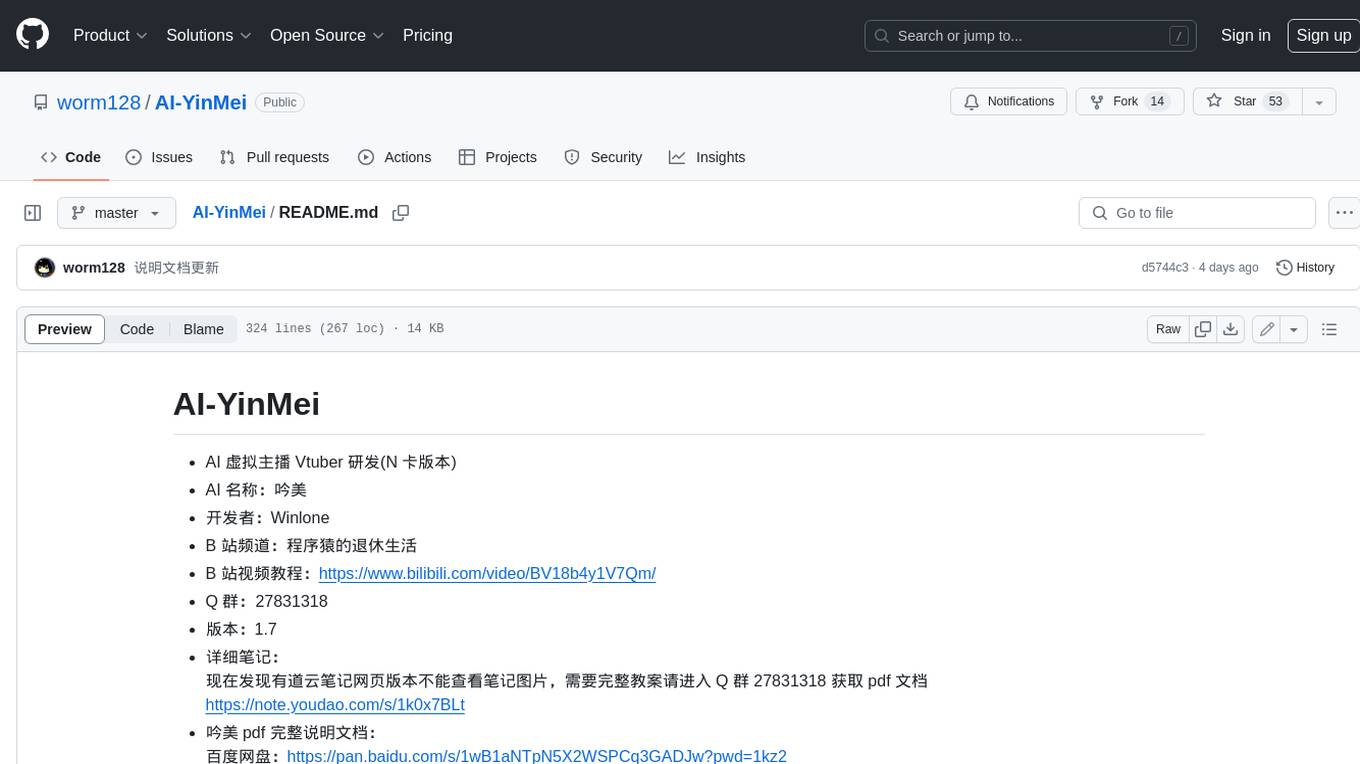
AI-YinMei
AI-YinMei is an AI virtual anchor Vtuber development tool (N card version). It supports fastgpt knowledge base chat dialogue, a complete set of solutions for LLM large language models: [fastgpt] + [one-api] + [Xinference], supports docking bilibili live broadcast barrage reply and entering live broadcast welcome speech, supports Microsoft edge-tts speech synthesis, supports Bert-VITS2 speech synthesis, supports GPT-SoVITS speech synthesis, supports expression control Vtuber Studio, supports painting stable-diffusion-webui output OBS live broadcast room, supports painting picture pornography public-NSFW-y-distinguish, supports search and image search service duckduckgo (requires magic Internet access), supports image search service Baidu image search (no magic Internet access), supports AI reply chat box [html plug-in], supports AI singing Auto-Convert-Music, supports playlist [html plug-in], supports dancing function, supports expression video playback, supports head touching action, supports gift smashing action, supports singing automatic start dancing function, chat and singing automatic cycle swing action, supports multi scene switching, background music switching, day and night automatic switching scene, supports open singing and painting, let AI automatically judge the content.







